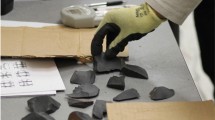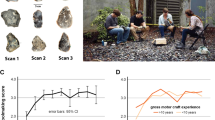Abstract
The evolution of the prominent role of the cerebellum in the development of composite tools, and cumulative culture, leading to the rise of Homo sapiens is examined. Following Stout and Hecht's (2017) detailed description of stone-tool making, eight key repetitive involvements of the cerebellum are highlighted. These key cerebellar learning involvements include the following: (1) optimization of cognitive-social control, (2) prediction (3) focus of attention, (4) automaticity of smoothness, appropriateness, and speed of movement and cognition, (5) refined movement and social cognition, (6) learns models of extended practice, (7) learns models of Theory of Mind (ToM) of teachers, (8) is predominant in acquisition of novel behavior and cognition that accrues from the blending of cerebellar models sent to conscious working memory in the cerebral cortex. Within this context, the evolution of generalization and blending of cerebellar internal models toward optimization of social-cognitive learning is described. It is concluded that (1) repetition of movement and social cognition involving the optimization of internal models in the cerebellum during stone-tool making was the key selection factor toward social-cognitive and technological advancement, (2) observational learning during stone-tool making was the basis for both technological and social-cognitive evolution and, through an optimizing positive feedback loop between the cerebellum and cerebral cortex, the development of cumulative culture occurred, and (3) the generalization and blending of cerebellar internal models related to the unconscious forward control of the optimization of imagined future states in working memory was the most important brain adaptation leading to intertwined advances in stone-tool technology, cognitive-social processes behind cumulative culture (including the emergence of language and art) and, thereby, with the rise of Homo sapiens.



Similar content being viewed by others
Data Availability
The concept reviewed and discussed in this manuscript is not based on raw data.
Notes
Autobiographical knowledge refers to one’s fluent or automatic knowledge (including abstract knowledge) of past and future action/interaction sequences related to the self [28].
Albert Einstein letter to Dr. H. L. Gordon, May 3, 1949. This is Item 58 -217 in the Control Index to the Einstein Archive which may be consulted at Mudd Library, Princeton University.
References
Akshoomoff N, Courchesne E, Townsend J. Attention coordination and anticipatory control. In: Schmahmann JD, editor. The cerebellum and cognition. New York: Academic Press; 1997. p. 575–98.
Guell X, Gabrieli JDE, Schmahmann JD. Triple representation of language, working memory, social and emotion processing in the cerebellum: convergent evidence from task and seed-based resting-state fMRI analyses in a single large cohort. Neuroimage. 2018;172:437–49. https://doi.org/10.1016/j.neuroimage.2018.01.082.
Higuchi S, Imamizu H, Kawato M. Cerebellar activity evoked by common tool-use execution and imagery tasks: an fMRI study. Cortex. 2007;43:350–8. https://doi.org/10.1016/S0010-9452(08)70460-.
Ito M. Movement and thought: identical control mechanisms by the cerebellum. Trends Neurosci. 1993;16(11):448–50.
Leiner H, Leiner A, Dow R. Reappraising the cerebellum: What does the hindbrain contribute to the forebrain? Behav Neurosci. 1989;103:998–1008.
Schmahmann JD, Guell X, Stoodley CJ, Halko MA. The theory and neuroscience of cerebellar cognition. Annu Rev Neurosci. 2019;42:337–64.
Vandervert, L. The prominent role of the cerebellum in the origin, advancement and individual learning of culture. Cerebellum Ataxias. 2016;3(10). https://doi.org/10.1186/s40673-016-0049-z
Vandervert L. How prediction based on sequence detection in the cerebellum led to the origins of stone tools, language, and culture and thereby, to the rise of Homo sapiens. Front Cell Neurosci. 2018;2018(12):408. https://doi.org/10.3389/fncel.2018.00408.
Vandervert L. The prominent role of the cerebellum in the social learning of the phonological loop in working memory: How language was adaptively built from cerebellar inner speech required during stone-tool making. AIMS Neuroscience. 2020;7(3):333–43. https://doi.org/10.3934/Neuroscience.2020020.
Van Overwalle F, Manto M, Cattaneo Z, Vandervert L, et al. The cerebellum-driven social learning of inner speech in the evolution of stone-tool making and language: Innate hand-tool connections in the cerebro-cerebellar system. Consensus paper: cerebellum and social cognition. Cerebellum. 2020. https://doi.org/10.1007/s12311-020-01155-1.
Ambrose S. Paleolithic technology and human evolution. Science. 2001;291:1748–53.
Kirby S. Culture and biology in the origins of linguistic structure. Psychon Bull Rev. 2017;24:118–37. https://doi.org/10.3758/s13423-016-1166-7.
Stout D, Hecht E. The evolutionary neuroscience of cumulative culture. PNAS. 2017;114(30):7861–8.
Ito M. Cerebellar microcomplexes. In: Schmahmann JD, editor. The cerebellum and cognition. New York: Academic; 1997. p. 475–87.
Ito M (2005) Bases and implications of learning in the cerebellum—adaptive control and internal model mechanism. In: DeZeeuw C, Cicirata F, editors. Creating coordination in the cerebellum (Progress in Brain Research, Volume 48 chap. 9). Oxford, England: Elsevier Science; p. 95–109
Ito M. Control of mental activities by internal models in the cerebellum. Nature Revs. 2008;9:304–13.
Van Overwalle F, Manto M, Leggio M, Delgado-García J. The sequencing process generated by the cerebellum crucially contributes to social interactions. Med Hypotheses. 2019;128. https://doi.org/10.1016/j.mehy.2019.05.014.
Leggio M, Molinari M. Cerebellar sequencing: a trick for predicting the future. Cerebellum. 2015;14:35–8.
Adamaszek M, Manto M, Schutter DJLG (Eds.) (2022) The emotional cerebellum. SpringerNature, Switzerland. https://doi.org/10.1007/978-3-030-99550-8.
Kawato M, Furukawa K, Suzuki R. A hierarchical neural-network model for control and learning of voluntary movement. Biol Cybern. 1987;57:169–85.
Vandervert L. The prominent role of the cerebellum in the origin of intertwined social and technological cumulative culture. In: Manto M, Marvel C, Vandervert L, editors. The New Revolution in Psychology and the Neurosciences (Chap. 4). Switzerland: Springer Nature. 2022.
Van Overwalle F, Mariën P. Functional connectivity between the cerebrum and cerebellum in social cognition: a multi-study analysis. Neuroimage. 2015. https://doi.org/10.1016/j.neuroimage.2015.09.001.
Leiner H, Leiner A, Dow R. Does the cerebellum contribute to mental skills? Behav Neurosci. 1986;100:443–54.
Washburn SL, Harding RS. Evolution Primate Behavior. In: Schmitt FO, editor. The neurosciences: second study program. New York: Rockefeller University Press; 1970. p. 39–47.
Ambrose S. Coevolution of composite-tool technology, constructive memory, and language: implications for the evolution of modern human behavior. Curr Anthropol. 2010;51:S135–47. https://doi.org/10.1086/650296. (0011-3204/2010/510S1-0014$10.00).
Koechlin E, Basso G, Pietrini P, Panzer S, Grafman J. The role of the anterior prefrontal cortex in human cognition. Nature. 1999;399:148–51. https://doi.org/10.1038/20178.
Ito M. The cerebellum: brain for an implicit self. Upper Saddle River: FT Press; 2011.
Sperduti M, Piolino P. Neural substrates of the self-memory system: new insights from a meta-analysis. Hum Brain Mapp. 2013;34:1515–29. https://doi.org/10.1002/hbm.22008.
Alderson-Day B, Fernyhough C. Inner speech: Development, cognitive functions, phenomenology, and neurobiology. Psychol Bull. 2015;141:931–65.
Vandervert, L. Psychology and neuroscience achieve the impossible: a new, revolutionary look inside the cerebellum-driven mind of albert einstein. In: Manto M, Marvel C, Vandervert L, editors. The New Revolution in Psychology and the Neurosciences (Chap. 1). Switzerland: Springer Nature. 2022.
Imamizu H, Higuchi S, Toda A, Kawato M. Reorganization of brain activity for multiple internal models after short but intensive training. Cortex. 2007;43:338–49.
Imamizu H, Kawato M. Brain mechanisms for predictive control by switching internal models: implications for higher-order cognitive functions. Psychol Res. 2009;73(4):527–44.
Imamizu H, Kawato M. Cerebellar internal models: implications for the dexterous use of tools. Cerebellum. 2012;11:325–35.
Courchesne F. Infantile autism. 2. A new neurodevelopmental model. Int Pediat. 1995;10:86–96.
Baddeley A. The episodic buffer: a new component of working memory? Trends Cogn Sci. 2000;4:417–23.
Panksepp J, Biven L. The archeology of mind: neuroevolutionary origins of human emotions. WW Norton & Company 2012.
Panksepp J. Affective neuroscience of the emotional brainmind: evolutionary perspectives and implications for understanding depression. Dialogues Clin Neurosci. 2010;12:533–45.
Marek S, Siegel JS, Gordon EM, Raut RV, Gratton C, et al. Spatial and temporal organization of the individual human cerebellum. Neuron. 2018;100(4):977-993.e7Martinelli.
Neubauer S, Hublin JJ, Gunz P. The evolution of modern human brain. Sci Adv. 2018;4(1):eaao5961.
Habas C. Topography of emotions in cerebellum as appraised by functional imaging. Adv Exp Med Biol. 2022;1378:77–86.
Lindquist KA, Wager TD, Kober H, Bliss-Moreau E, Barrett LF. The brain basis of emotion: a meta-analytic review. Behav Brain Sci. 2012;35(3):121–43. https://doi.org/10.1017/S0140525X11000446.
Jastorff J, Huang YA, Giese MA, Vandenbulcke M. Common neural correlates of emotion perception in humans. Hum Brain Mapp. 2015;36(10):4184–201.
Keren-Happuch E, Chen S-HA, Ho M-HR, Desmons JE. A meta-analysis of cerebellar contribution to higher cognition in PET and fMRI studies. Hum Brain Mapp. 2014;35(2):593–615.
Morawetz C, Bode S, Baudewig J, Jacobs AM, Heekeren HR. Neural representation of emotion regulation goals. Hum Brain Mapp. 2016;37(2):600–20.
Buckner RL, Krienen FM, Castellanos A, Diaz JC, Yeo BT. The organization of the human cerebellum estimated by intrinsic functional connectivity. J Neurophysiol. 2011;106(5):2322–45.
Guell X, Schmahmann JD, Gabrieli J, Ghosh SS. Functional gradients of the cerebellum. Elife. 2018;2018(7):e36652.
Adamaszek M, D’Agata F, Ferrucci R, Habas C, Keulen S, Kirkby KC, Leggio M, Mariën P, Molinari M, Moulton E, Orsi L, Van Overwalle F, Papadelis C, Priori A, Sacchetti B, Schutter DJ, Styliadis C, Verhoeven J. Consensus paper: cerebellum and emotion. Cerebellum. 2017;16(2):552–76. https://doi.org/10.1007/s12311-016-0815-8.
Adamaszek M, Cattaneo Z, Ciricugno A, Chatterjee A (2022) The cerebellum and beauty: the impact of the cerebellum in art experience and creativity. In: Adamaszek M, Manto M, Schutter DJLG (eds) The Emotional Cerebellum. Advances in Experimental Medicine and Biology, vol 1378. Springer, Cham. https://doi.org/10.1007/978-3-030-99550-8_14
Ferrari C, Ciricugno A, Arioli M, Cattaneo Z. Functional segregation of the human cerebellum in social cognitive tasks revealed by TMS. J Neurosci. 2023;43(20):3708–17.
Salvi C, Beeman M, Bikson M, McKinley R, Grafman J. TDCS to the right anterior temporal lobe facilitates insight problem-solving. Sci Rep. 2020;10:946. https://doi.org/10.1038/s41598-020-57724-1.
Parsons L, Sergent J, Hodges D, Fox P. The brain basis of piano performance. Neuropsychologia. 2005;43:199–215.
Henschke JU, Pakan JMP. Engaging distributed cortical and cerebellar networks through motor execution, observation, and imagery. Front Syst Neurosci. 2023;17:1165307. https://doi.org/10.3389/fnsys.2023.1165307.
Van de Cruys S, Wagemans J. Putting reward in art: a tentative prediction error account of visual art. i-Perception. 2011;2(9):1035–62.
Holloway RL. Culture, symbols, and human brain evolution: a synthesis. Dialect Anthropol. 1981;5:287–303.
Holloway R. The human brain evolving: a personal retrospective. Ann Rev Anthro. 2008;37:1–19. https://doi.org/10.1146/annurev.anthro.37.081407.085211.
Einstein A. Autobiographical notes. In: Schillp A, editor. Albert Einstein: Philosopher-scientist, vol. 1. La Salle, IL: Open Court; 1949. p. 1–95.
Funding
This project was executed without financial support from any governmental, commercial or not-for-profit organizations. CHECK.
Author information
Authors and Affiliations
Contributions
Project administration, LV, MM; Writing: all. All authors have read the final version and agreed on publication.
Corresponding author
Ethics declarations
Competing Interests
The authors declare no competing interests.
Ethical Committee Request
Not applicable.
Consent for Publication
All authors consent for publication of this review.
Additional information
Publisher's Note
Springer Nature remains neutral with regard to jurisdictional claims in published maps and institutional affiliations.
Rights and permissions
Springer Nature or its licensor (e.g. a society or other partner) holds exclusive rights to this article under a publishing agreement with the author(s) or other rightsholder(s); author self-archiving of the accepted manuscript version of this article is solely governed by the terms of such publishing agreement and applicable law.
About this article
Cite this article
Vandervert, L., Manto, M., Adamaszek, M. et al. The Evolution of the Optimization of Cognitive and Social Functions in the Cerebellum and Thereby the Rise of Homo sapiens Through Cumulative Culture. Cerebellum (2024). https://doi.org/10.1007/s12311-024-01692-z
Accepted:
Published:
DOI: https://doi.org/10.1007/s12311-024-01692-z




